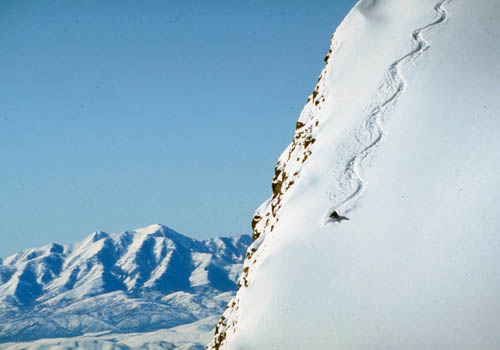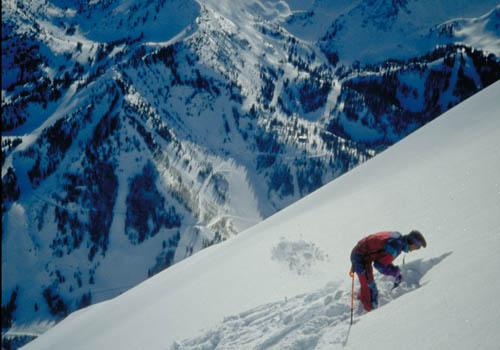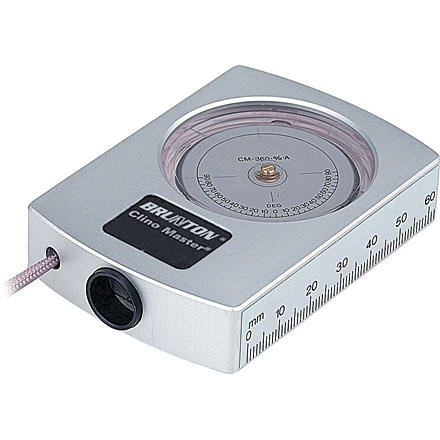Developing an Eye for Angles – Part 2
Part of the challenge of correctly identifying slope angles by eye is that they often look much steeper when viewed straight-on than they do from the side. (This is also a good photography trick – shooting straight-on, like from a helicopter or across a valley makes the slopes look lots steeper). A classic case of this is Mt. Superior, which when viewed directly across the canyon from Alta or Snowbird, looks really steep, but when you actually ski it, it’s about like a black diamond run at a resort – not too bad.
Something to keep in mind is that your angle-sense changes when you move to different areas. For instance, the snow in Alaska sticks to steeper slopes than in the Wasatch, so all of those little visual clues you subconsciously pick up on are off. As a result, I often underestimate my maritime snowpack angles and overestimate the continental ones.
Any way you physically measure a slope is better than nothing, although the generally agreed on best method is to sight down it with an accurate clinometer, or get it from a distant side view. Measuring it directly on the snow, or on a pole on the snow (as shown in yesterday’s post) may pick up unwanted dips or roll-overs. Keeping a compass/clinometer in a chest pouch or front zipper pocket makes it easy and painless to grab a quick angle.
________________________________
Help support StraightChuter.com and measure slopes to the nth degree with a Brunton Clinomaster on sale now at Backcountry.com. Click on the photo below…
Category: 07 Avalanche Avoidance












I really like using the Life-Link slope meters, i often carry it with me on side-country jants too, and will stop during a run to take a quick measure, i’ll get curious what I’m skiing and I’m often amazed that what seems like a much steeper line is really 5 deg less. Its tricky still to lay down your meter against your pole and not get some +/- 3 deg deviations depending on the way you lay the pole, I find I have to lay it down a few times and get an average… guess need more practice :)
wow, that is a deceptive picture!
clinometers seem to run expensive, an insult to the injury of high price tag of ski equipment. i’ve found that i can get a fairly accurate reading by useing a cheapo plastic protractor (found at any rite-aid etc…) they all have holes at the midpoint of the semicircle where you can fit a paperclip or peice of wire to, and then just line the straightedge with a pole like you would a 30$ lifelink one.
Hey, Andrew
Thanks for the photos, its so tricky to show the true steep line, in climbing or skiing, it always helps to study some photos that show it well!
Kate
Even though I’ve gone through about ten of the Life-Link clinometers, they are probably still my favorite. If they could make them smaller and more durable, they’d be perfect. I used a Suunto watch for a while, which seemed to work, but I thought it was kind of awkward.
Skoogs photo is incredible. I want to ski that sometime. Great post !!
Hi Julian – that was one of the first times I’d ever met Carl Skoog and I didn’t really understand what he was doing fooling around on top of Superior while we were over skiing Monte Cristo. Only after I saw his photos vs. mine did I realize what a great photographer he was.
There are some big cliff in that area as well that are just waiting to be jumped…